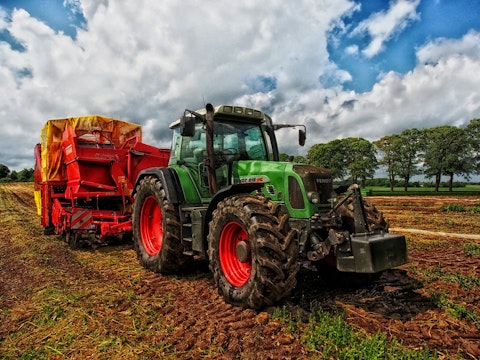AGCO Corporation (NYSE:AGCO) Q4 2022 Earnings Call Transcript February 7, 2023
Operator: Good morning and welcome to the AGCO Fourth Quarter 2022 Earnings Conference Call. Please note this event is being recorded. I would now like to turn the conference over to Greg Peterson, AGCO Head of Investor Relations. Please go ahead.
Greg Peterson: Thanks Anthony and good morning. Welcome to those of you joining us for AGCO’s fourth quarter 2022 earnings conference call. We will refer to a slide presentation this morning that’s posted on our website at www.agcocorp.com. The non-GAAP measures used in that presentation are reconciled to GAAP metrics in the appendix of that presentation. We will also make forward-looking statements this morning on our call with respect to demand, product development and capital expenditure plans, production levels, engineering expense, exchange rates, pricing, share repurchases, dividends, interest rates, future commodity prices, crop production, supply chain disruption, inflation, component delivery, sales, margins, earnings, cash flow, tax rates and other financial metrics.
We wish to caution you that these statements are predictions and that actual events may differ materially. We refer you to the periodic reports that we file from time-to-time with the Securities and Exchange Commission, including the company’s Form 10-K for the year ended December 31, 2021. These documents discuss important factors that could cause the actual results to differ materially from those contained in our forward-looking statements. These factors include, but are not limited to, adverse developments in the agricultural industry, including those resulting from COVID-19, such as plant closings, workforce availability and product demand. They also include supply chain disruption, weather, exchange rate volatility, commodity prices and changes in product demand.
We disclaim any obligation to update any forward-looking statements except as required by law. A replay of this call will be available on our corporate website later today. On the call with me this morning are Eric Hansotia, our Chairman, President and Chief Executive Officer; and Damon Audia, our Senior Vice President and Chief Financial Officer. With that, Eric, please go ahead.
Eric Hansotia: Thanks, Greg. Good morning. It’s great to be with you. We finished 2022 incredibly well from both an operational and financial perspective. But before we get into those details, I want to start with a quick recap of the Investor Day we hosted in December. Those of you that attended will recognize this slide from that meeting. It’s the foundation of our strategy all in one page. The purpose, vision and overarching strategy we laid out at the 2021 investor meeting haven’t changed. We are concentrated on delivering farmer-focused solutions to sustainably feed our world. These solutions are more than machinery. They are all about the data, technology, connectivity and digital solutions around the machines. Sustainability is also key to who we are.
It weaves through our day-to-day activities and is a cornerstone of our strategy. Finally, feeding the world energizes our purpose. While our strategy hasn’t changed, we are doubling down on our key strategic initiatives, growing faster than the market, optimizing our business and fostering a culture that enables success. We have raised the bar on our technology commitments and our financial performance, particularly in our operating margin performance. You will see that as we move to our fourth quarter results. This focus is already paying off in terms of strong top line growth and a very healthy margin expansion. Slide 4 highlights our great finish to 2022. We posted a record fourth quarter and full year in terms of sales, operating margin and earnings.
I would like to deeply thank AGCO’s 25,000 employees for their hard work that resulted in the world class support for our farmer customers throughout this challenging year. These efforts helped deliver fourth quarter sales growth of 24%, with adjusted operating margins expanding by 340 basis points to 12%. For the full year, our net sales reached almost $12.7 billion. Adjusted operating margins improved to 120 basis points to 10.3% and adjusted earnings per share hit $12.42. Now, these are all records for AGCO. During 2022, while delivering record results, we also executed an ambitious investment plan to expand our smart farming solutions and enhance our digital capabilities through increased engineering spend and several key acquisitions. Overall, I could not be prouder of our team.
These record results are a testament to our focused execution on our strategy while continuing to deal with supply chain challenges during the year. While the supply chain has improved over the last couple of quarters, we continue to experience significant component shortages that are impacting our production volumes. The encouraging news is that despite the global supply bottlenecks and inflationary pressures, farmer economics remain healthy and the global end market demand remains strong. We expect supportive market conditions to continue into 2023. Our financial outlook for 23 reflects this optimism, which will allow us to accelerate technology-related investments as well as continue to return cash to our shareholders. Slide 5 details industry unit retail sales by region for the full year of 2022.
Support of farmer economics resulted in robust demand for larger agricultural equipment as farmers continued to replace aging machines during the year. Supply chain constraints limited industry production and dealer inventory levels of new and used large ag equipment remain well below normal levels across the industry. For 2022, global industry retail sales of farm equipment were lower in North America and Europe despite significantly higher sales of larger machines. North America industry retail tractor sales were down approximately 5% for the full year compared to 2021. Smaller tractor sales declined from record levels in 2021, while increased sales of higher horsepower units helped dampen the decline. Industry retail tractor sales in Western Europe, which also were restricted by supply chain challenges, decreased approximately 9% in 2022 compared to robust levels in 2021.
In South America, industry retail tractor sales increased 3% during 2022. Strong growth in Argentina and the smaller South American markets offset modestly lower overall sales in Brazil, despite strong demand for large ag equipment. Healthy crop production and favorable margins are supporting farm profitability. These supportive economics are expected to drive healthy demand in South America again throughout 2023. We are very positive about the underlying ag fundamentals supporting strong industry demand in 2023. Stocks-to-use levels of green all around the world remain at very low levels, supporting healthy commodity prices. With China’s reopening, we don’t think that will change anytime soon. The dealer channel for new and used equipment is still below target levels from the constrained supply.
Input costs like fertilizer and fuel are down significantly from their peaks last year. While farm income maybe down modestly in 2023 from record levels in 22, we think it will remain at a very good level in 2023 and be supportive for industry demand. Currently, we don’t see that changing much for 2024. AGCO’s 2022 factory production hours are shown on Slide 6. You can see that our production increased in 2022 in line with our expectations. Although we continued to face supply chain and logistics challenges, we were successful in reducing our inventory as semi-finished products. In the fourth quarter, we reduced the work-in-process inventory by nearly $275 million compared to the level at the end of the third quarter. For the full year, production hours increased approximately 6% compared to the 2021 levels as we worked to satisfy the strong demand.
Based on our industry and market share forecast, we are projecting a 3% to 5% increase in production hours for 2023. At year end, AGCO’s global order board remained extended and is approximately flat compared to the strong December of 2021 level. Orders for tractors and combines were higher in Western Europe and South America compared to a year ago. In North America, orders were down from 2021 levels as we have elected to limit our order intake to improve our on-time delivery rates. Our order coverage extends through the third quarter of 2023 in Western Europe and North America and through the second quarter of 2023 in Brazil where we continue to limit our orders to around one quarter in advance to give ourselves more pricing flexibility. The bottom line, demand for our farmer-focused products remains very strong.
You’ll recognize Slide 7 which highlights our focus on three high-margin growth areas. These opportunities provide significant growth potential at higher margins and less variability during the cyclical downturns. The first focus area is taking our Fendt full-line brand global. We continue to grow the business along two vectors. The first, we expanded the Fendt product line beyond tractors to now include key products like sprayers, planters, combines and more. The second mention is taking this full line of Fendt products global. As you can see in our results, interest continues to grow for our premium Fendt product lines in both North and South America. In 2022, our Fendt branded sales in those markets increased over 31% compared to 2021. Our Fendt and Challenger sales in North and South America are expected to double over the next 4 to 6 years.
The second focus area is our global parts and service business. AGCO is already in a leading position in fill rates, which is just effectively having the right part at the right place when the farmer needs it. We are building from a solid foundation to capture more of the dealers and farmers business. We are helping dealers become better and more proactive with their service and parts offerings with our smart solutions and expanding digital capabilities. As a result, we expect our high margin after-sales and parts business to continue to grow and have higher penetration rates. The third focus area involves precision agriculture. At AGCO, we address the Precision Ag market in two ways. First is through our Precision Planting business, which has become one of the most successful ag tech companies in the world.
Precision Planting has been a leader in providing automation and intelligence to planters. Over the last couple of years, it’s growing beyond planters into the other parts of the crop cycle, like spraying, soil testing and harvesting. In addition to its impressive technology, Precision Planting’s success is generated through their unique OEM-agnostic retrofit approach, which reduces the farmer’s upfront investment and increases their ROI regardless of the equipment brand that they own. By offering solutions through this retrofit approach, we are expanding the addressable market well beyond AGCO brands to all industry brands. The other way we address the Precision Ag opportunity is Fuse, which provides OEM solutions for our AGCO equipment. Regarding advanced technology, we remain focused on driving technology innovations that help our farmers improve their productivity, profitability and sustainability.
As we have seen multiple times, these types of innovations are receiving strong recognition in the form of industry awards. Just recently, AGCO won 10 Innovation AE50 awards from ASABE, which recognizes the best innovations and technologies for agriculture, food and biological systems. Not only was this the most awards of any company but more than our top two competitors combined. Going a little deeper into our technology, our unique retrofit approach caters to a huge audience. There is nowhere better to showcase this and to educate our farmers than our Precision Planting Winter Conference which held its annual event last month. At this event, we hosted nearly 7,000 of the best farmers in the world to hear directly from our engineers and agronomists about product development and research we have done in the field.
I attend this program myself every year. I had the chance to have lunch with farmers from Kazakhstan, Ukraine and Poland. All those that attended had the opportunity to see the latest Precision Planting technologies and learn how these advancements can help improve the productivity on their farms. Historically, the new product introductions had been focused on planters. However, starting last year, Precision Planting broke from that tradition and made a big announcement as they brought five needed solutions to the sprayer, including adding a neural network onto the 2020 architecture, leveraging artificial intelligence capabilities for targeted spraying solutions. The team continued their momentum of solving the farmers’ biggest problems this past summer by announcing it was revolutionizing soil testing with the introduction of Radicle Agronomics soil testing technology.
Radicle boasts the world’s first fully-automated soil laboratory and one of the AE50 Award winners this year. This new product disrupts the 100-year-old soil testing model and puts the capability into the hands of local agronomists with faster and more reliable results. Understanding how to improve soil health is great for farm productivity, but also great for the emerging need of carbon sequestration. At this year’s conference, our Precision Planting team made another disruptive launch with their new Panorama Data app. The new app, pictured on Slide 9, makes Precision Planting data the most usable, portable and shareable planter information on the planet. Panorama modernizes the way our 2020 controller interacts with the world. It helps farmers better utilize collected data by allowing for easy uploads to the platform of their choice.
Panorama allows farmers an unobstructed view of the data collected in their cab, whether on their app or through moving data to the platform of their choice. Panorama will feature map viewing, reporting and the ability for a farmer to allow their Precision Planting dealer to provide remote technology support. We are very excited about continuing to bring these types of precision ag technologies to our farmer customers, with our core focus of trying to solve their biggest challenges which will also contribute to our growth and margin expansion goals for AGCO. With that, I will now hand over the call to Damon who will provide you more information about our fourth quarter results.
Damon Audia: Thank you, Eric and good morning everyone. I will start on Slide 10 with an overview of AGCO’s regional net sales performance for the fourth quarter and the full year. Net sales were up approximately 33% in the quarter compared to the strong fourth quarter of 2021 when excluding the negative effects of currency translation. Pricing in the quarter, which was around 13% contributed to higher sales, along with strong growth in high horsepower tractors, combines and precision ag products. By region, the Europe/Middle East segment reported an increase in net sales in the fourth quarter of approximately 38%, excluding the negative effect of currency translation compared to the prior year. The increase in sales was the result of solid execution of product deliveries, coupled with favorable pricing and strong retail demand in Germany, France and Turkey.
In South America, net sales in the fourth quarter grew approximately 58% year-over-year, excluding favorable currency translation, driven by significant pricing as well as increased volume and positive mix. Sales were up strongly across the South American markets with high horsepower tractors and combines showing the largest increases. Net sales in North America increased approximately 23%, excluding the unfavorable impact of currency translation compared to the fourth quarter of 2021. The increase resulted from higher sales of large tractors, Precision Planting products and combines as well as strong year-over-year price increases. On a constant currency basis, net sales in our Asia/Pacific/Africa segment decreased about 15% compared to the fourth quarter of 2021.

Pixabay/Public Domain
Delays of shipments from our European factories resulted in lower sales across the Asia/Pacific/Africa markets relative to the strong fourth quarter last year. Finally, consolidated replacement parts sales were approximately $366 million for the fourth quarter, approximately flat year-over-year. Unfavorable currency effects were around 10% during the fourth quarter. Turning to Slide 11, the fourth quarter adjusted operating margin improved by approximately 340 basis points versus 2021. Margins in the quarter benefited from higher sales and production, a richer mix and positive net pricing compared to the fourth quarter of 2021. Price increases in the quarter of approximately 13% more than offset significant material and freight cost inflation on a dollar basis and were positive on a margin basis.
For the full year, net pricing was positive and contributed to the overall margin improvement. By region, the Europe/Middle East segment reported an increase of approximately $100 million in operating income compared to the fourth quarter of 2021 and margins improved approximately 250 basis points. Higher sales and healthy products mix contributed to the improvement. North American operating income for the fourth quarter increased approximately $37 million year-over-year. Higher sales of margin-rich products more than offset higher operating expenses. Operating margins in South America reached 20% in the fourth quarter and operating income improved over $85 million versus the same period in 2021. Continued significant increases in end market demand, along with strong pricing and a healthy sales mix supported the year-over-year growth.
Finally, in our Asia/Pacific/Africa segment, operating income declined approximately $19 million in the fourth quarter, reflecting the delivery timing challenges I mentioned earlier. With margin expansion in the last 2 years in our North American, South American, Asia-Pacific, Africa regions from our strategy execution and disciplined pricing, we expect AGCO’s margin profile to be more balanced across the globe in the years ahead. Slide 12 summarizes our Precision Ag business. As you can see, we are focused on expanding our addressable market from just traditional agriculture machinery spend, which today is in the low to mid-teens. With our Precision Ag portfolio, our sites are set around 70% for all non-land areas. We believe that the investment in Precision Ag positions us well as we will play a major role in achieving global sustainability targets that are being established while simultaneously helping our farmers improve their profitability.
Finally, we recorded $700 million in Precision Ag revenue in 2022, a 29% increase from 2021. Unfavorable foreign currency effects were around 3% in 2022. As we announced during our December Investor Day, we now expect our high-margin Precision Ag business to grow to $1 billion by 2025. Slide 13 details our full year free cash flow for 2022 and 2021. As a reminder, free cash flow represents cash used in or provided by operating activities less capital expenditures. And free cash flow conversion is defined as free cash flow divided by adjusted net income. While we made significant sequential progress in reducing our work-in-process inventory in the fourth quarter and generated over $1 billion in free cash flow, working capital requirements related to supply chain challenges continue to result in higher than traditional inventory levels.
This affected free cash flow in both 2021 and 2022. Despite that, AGCO generated $450 million in free cash flow in 2022, up 15% versus 2021. For 2023, we expect our raw material and work-in-process inventory to remain somewhat elevated, given supply chain challenges, but we expect it to be a modest source of cash versus 2022. We expect our free cash flow conversion to range from 75% to 100% of adjusted net income, a significant increase from 2022. Our capital allocation priorities remain unchanged and will continue to include investments in our Precision Ag offerings and digital capabilities as well as opportunistically adding bolt-on acquisitions to help position AGCO for long-term success. In addition, we remain focused on our direct returns to investors during 2022 with a regular quarterly dividend that we increased 20% to $0.24 per share and a variable special dividend of $4.50 per share.
Future returns of cash to shareholders will be based on cash flow generation, our investment needs, which include capital expenditures and acquisition opportunities as well as our market outlook. Slide 14 highlights our 2023 retail market forecast for our three major regions. Globally, driven by strong commodity prices, we expect healthy farm economics to support another year of strong end market demand. For North America, we expect similar demand compared to the healthy levels in 2022. We expect continued growth in high horsepower row crop equipment segment to be offset by softer demand for smaller equipment after the several years of strong growth. Increasing interest rates are expected to continue to slow the smaller equipment segment of the market.
In South America, we expect industry sales to be flat to up 5%, moderated by supply chain constraints. This region remains one of the strongest end markets, especially in Brazil, where they are forecasting record production and strong farmer profitability, which we expect to drive demand for large ag equipment beyond 2023. As grain exports from Brazil are expected to increase over the next several years and they continue to increase arable land, we expect the demand for our large ag equipment to remain strong. Shifting to Western Europe, the industry is forecasted to be relatively flat compared to 2022. Farm fundamentals in the region are generally healthy with grain prices continuing to outpace input inflation. Meanwhile, supply chain constraints last year are extending the equipment replacement into 2023.
Slide 15 highlights a few key assumptions underlying our 2023 outlook. In addition to focus on meeting the robust end market demand, we will also make significant investments in the development of new solutions to support our Farmer First strategy. Although we see strong market demand, AGCO’s results will still be dependent upon our supply chain performance in 2023. Our sales plan includes market share gains along with price increases of approximately 8% aimed at offsetting material cost inflation. We expect currency translation to negatively impact sales by about 1%. Engineering expenses are expected to increase by approximately 20% compared to 2022. The increase is targeted at investments in smart farming and precision ag products. Operating margins are expected to improve to around 10.5%, driven by higher sales and production, favorable pricing, net of material cost, and improved factory productivity, partially offset by increased investments in our engineering and digital initiatives as well as inflationary cost pressures.
With increasing interest rates and higher sales forecasted, we expect other expenses mainly related to accounts receivable sales to increase approximately $50 million year-over-year, with the majority of that in the first half of 2023. We are targeting an effective tax rate in the range of 27% to 28%. Turning to Slide 16. Our financial goals remain unchanged from what we highlighted at our December Investor Day. We are currently expecting net sales to be in the range of $14 billion. Earnings per share should be around $13.50 in 2023. We are targeting capital expenditures of $375 million. As I mentioned earlier, free cash flow conversion should be in the range of 75% to 100% of adjusted net income, consistent with our long-term target. With that, I’ll turn the call back to Greg for Q&A.
Greg Peterson: Thanks, Damon. Anthony, with that, please get us started.
See also 10 Dumbest Companies to Invest In and Top 25 Agrochemical Companies in the World.
Q&A Session
Follow Agco Corp (NYSE:AGCO)
Follow Agco Corp (NYSE:AGCO)
Operator: Our first question will come from Jamie Cook with Credit Suisse. You may now go ahead.
Jamie Cook: Good morning, and congrats on a nice quarter. I guess my first question, just South America, I don’t think I’ve ever seen a 20% margin for you guys in South America. But just as we think about the margin performance that you put up in 2022, how much is sort of structural or related to increased sales of Fendt or aftermarket or Precision Ag versus just pricing power? And I’m just wondering how I think about the margins longer-term, just given the strength you guys have seen in 2022. And then my second question, again, strong margin performance. What parts of the portfolio are underperforming, if any? Perhaps GSI, can you help us with where GSI margins ended this year versus the opportunity going forward? Thank you.
Damon Audia: Yes. Sure, Jamie. So if we look at South America, your first point, as we’ve said for the last couple of quarters now, the margins have been exceptional and really twofold. One has been the structural improvements that we’ve made in South America over the last several years to really move to the higher horsepower type tractors, introducing Fendt there, and that has created some structural differences to our overall operating performance. That, coupled with probably the strongest end market that we have right now around the world, is really catering to stronger pricing. So like you said, the 20% in the quarter was exceptional. As we tried to guide, we do think margins will come down a little bit here in 2023 as our pricing, our team down there has done a really good job in pricing in advance of material costs rising.
So we know that will come down. What we would say is longer term we do expect to see South America structurally different and sort of in that low to mid-teens for the long-term. So again, a lot of improvement over the past couple of years, but we’re at sort of a high point, and we continue to expect to see that at least for the foreseeable future but a little bit lower as we move into 2023. To your second part of your question on some of the underperforming areas, I think we would say the grain and protein group did struggle a little bit relative to what we were expecting. It was sort of challenged by a couple of things in the start of the year with the steel prices really affected here in North America. We dealt with the cyber event, as you recall, in the second quarter, which really put incremental pressure on grain and protein here in North America.
And then the Asia-Pacific part of grain and protein was really challenged by the challenges in China with the COVID lockdowns affecting a lot of the business there. So those two parts of grain and protein, I would say, were below what we were hoping. South America grain and protein did quite well, was a contributor there. We’ve taken some structural actions, as you know, to really improve that business. We’ve done some factory closures. We’ve added some technology-type acquisitions as part of that portfolio. So as we move into 23, we are expecting it to improve profitability. It was profitable here in 2022, I would say, low single digits, but again, overall profitable business with a big improvement or a bigger improvement expected here in 2023.
Jamie Cook: Thank you very much. I will get back in queue.
Operator: Our next question will come from Tami Zakaria with JPMorgan. You may now go ahead.
Sean McMullen: Hi, thanks. This is Sean McMullen on for Tami. Last quarter, I think you mentioned around $300 million of sales that got pushed into 4Q. Can you just provide an update on where kind of red-tag units stand today and whether that all got worked through at year-end? And then also in your prepared remarks, you mentioned the mix shipments in APA. Can you provide just some quantification or details on whether that all kind of gets delivered in 1Q?
Damon Audia: Yes, Sean. So I think the team did a really good job in working through the semi-finished inventory around the world. Asia I’d say Europe did an exceptional job where very little, if any, left over there. I’d say the one region where we still have a little bit of semi-finished inventory was here in North America. And again, that was driven more by some supply challenges. As things are getting better, there are still one or two suppliers that pop up. And so we had a little bit of semi-finished inventory here in North America. But overall, the teams around the world did a very good job. My comment about the in-transit inventory again, as we work through some of the products, again, a couple of hundred million are probably on the water here that we would expect to move through the system, depending on the selling season, more likely in the first half of 2023 rather than just the first quarter.
But again, that’s more of a hopefully a timing issue for us than anything.
Sean McMullen: Great. Thanks, Damon. And my second question is more focused on Precision Ag. Can you just kind of give the split of kind of your expectations for growth this year as well as kind of Precision Planting versus Fuse? And then also, do you expect kind of more normal seasonality for Precision Planting this year?
Damon Audia: Yes. I think, Sean, historically, it was much more of a first half weighted sales, given the planting season. Last year, with the strong demand, some supply chain disruptions, we saw more of an equal cadence of sales. I would tell you, as we look at the demand right now, we’re probably going to see something similar to what we had in 2022, so a little bit more balanced than the historical first half, second half. But overall, still strong demand there. Precision Planting itself was up around 39% last year, so very strong demand, a little bit stronger than what we saw in Fuse again. And that’s given that OEM-agnostic backdrop where we’re able to cater to all OEMs from a retrofit basis. So very strong demand there. And again, as we think about that growth from $700 million this year to our target of $1 billion by 2025, a lot of that is coming from our Precision Planting business. So we see good growth coming here in 23 as well.
Sean McMullen: Great, thanks. Appreciate the color.
Operator: Our next question will come from Jerry Revich with Goldman Sachs. You may now go ahead.
Jerry Revich: Yes. Hi, good morning, everyone. Eric, I wonder if we could just talk about in North America, considering how strong the margins are of the Precision Planting product, it looks like on the legacy tractor products, you folks might be running in the mid-single digit margin range. And so given the Fendt rollout, can you just talk about how much line of sight do you have to use that rollout as a tool to take North America margins higher? What’s an opportunity set?





